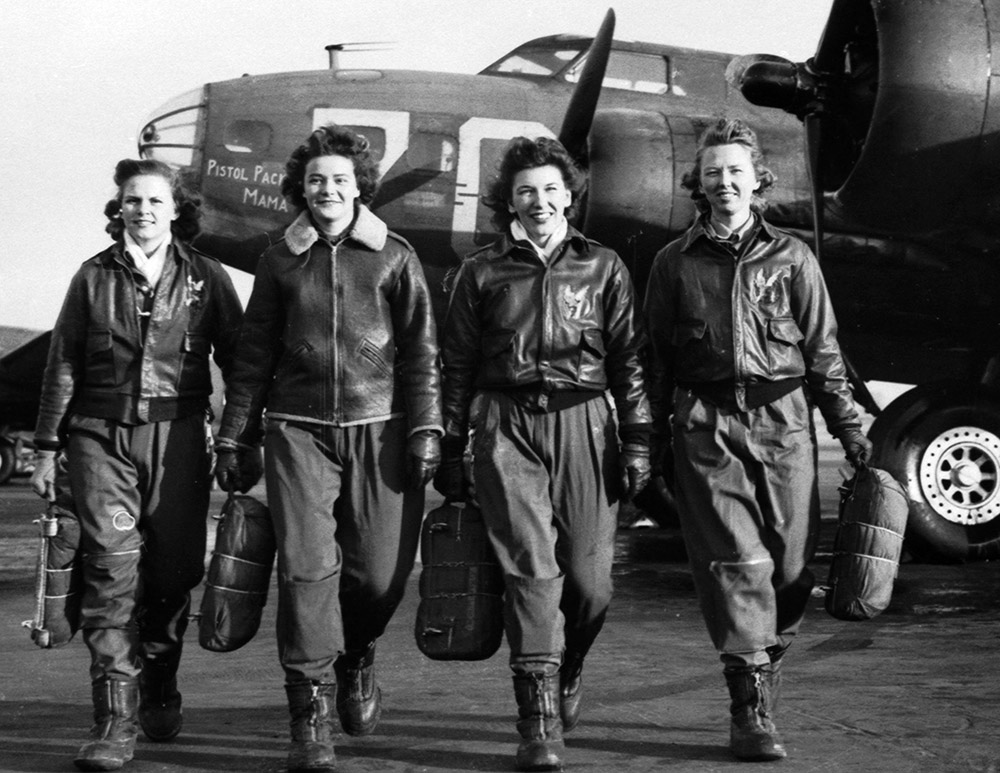
25,000 applied. Only an elite group of 1,074 were accepted.
They were the trailblazing women known as the W.A.S.P. (Women Airforce Service Pilots) who brazenly pushed through barriers and opened doors for women in World War II, by serving our country from 1942-1944. And they risked it all for an idea that could change the world.
They dared to break barriers and charter territory unprecedented for women and showed a generation of young women that achieving your dreams is possible and that you could be anything you wanted to be – including a pilot.
These volunteers, who stepped up when the U.S. was in short supply of pilots even though they were not allowed to fly for their own country, flew 60 million miles; ferried planes around the world; worked as instructors and test pilots; helped train male pilots for combat and flew every type of military plane from basic trainer to B-29s.

They would be used as “target” practice for the men. They would tow a target behind their plane and up in the sky, and the men in their bomber planes would shoot live ammunition from the gunners of their B-24s at the target.
When our country called, these brave women volunteered to serve as pilots during the war. They received the same training as their male colleagues, yet, they were never commissioned as officers in the U.S. Army and were paid less than their male counterparts.
They had worn the uniform, and 38 of them died in service to their country. However because they were considered volunteers and not soldiers, they received none of the benefits or recognition of their male veterans.
Congress disbanded the W.A.S.P. in 1944 without benefits. And it would take over 30 years and a long struggle from surviving W.A.S.P.s, their families, and other women, to have their military service acknowledged and be granted veteran status from Congress in 1977.
In 2010, they were awarded the Congressional Gold Medal.
What does it take to transform an idea into action?
And why does one person’s vision catalyze movements, while another burns out before it builds momentum?
Women know all too well that instigating change in the status quo often requires more than polite requests and ladylike charm; the truth is, sometimes to make change happen, you have to stand up and fight for it.

The W.A.S.P.s believed in one simple idea: that women pilots were as capable and qualified as men pilots. And they were willing to put it all on the line and fight for it. That one idea sparked a shift in perception and attitudes that reverberates today.
What about you? As a leader in your workplace, social group, or community, are you willing to champion a cause to instigate change? Would you boldly step forward in support of an idea that you believe could change the world?
And when do inspiration and passion become a cause worth fighting for?
Often, the most difficult part of leading change is knowing where to start.

Tweet: When do inspiration and passion become a cause worth fighting for?
Here are 5 small actions you can take to ignite change in your circle of influence:
- Adopt a cause that inspires you. Whether you feel moved to put your support behind women’s equality, clean drinking water, or the environment, is irrelevant. What matters is that you feel called to take action.
- Invest your time to learn more. Take time to discover the challenges and what needs to be done at the grassroots level.
- Listen first; act second. Don’t assume that you know what needs to be done. Listen to all sides and make informed choices.
- Respond with compassion. It’s important to remember that both sides of every issue have people who strongly believe in their cause. There is never just one side of the story.
- Enlist the help of others. Trying to do it all alone will burn you out. Band together with people who are also inspired by the cause. Share ideas, and work toward a common goal.
In 2002, the WASPs were granted burial rights at Arlington National Cemetery and since that time numerous WASPs have been buried or interred there. Now the Department of the Army, which manages Arlington National Cemetery, says that despite their service these brave women don’t qualify for burial at Arlington. The best course of action is to urge Congress to change the law.
If you would like to support these amazing pioneers, you can lend your name here.
“I (we) never forgot our values: Honor, Integrity, Patriotism, Service,
Faith and Commitment.” – W.A.S.P. Deanie Parrish




